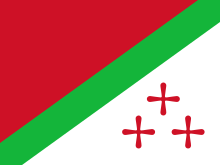Katanga cross

The Katanga -Kreuz (also known as Handa or Aspa referred to) is a cross-shaped copper - bars and one of the primitive money kinds in the field of today's Congo and around. It was a means of payment and at the same time the bar form for the copper trade. It can be proven as a means of payment between the 13th and the beginning of the 20th century.
The production takes place as a cast in lost form in various modifications. Older and smaller forms are more likely to be found in "H" form, later in "X" form. The variety is also reflected in different sizes and weights (e.g .: 474, 530, 938, 1010 g). There were also oversized pieces that probably only had a prestige effect or it is believed that they were used to attract particularly sought-after women.
The pride of the country's copper abundance (the Copperbelt in Katanga and Zambia is the most important copper mining area in Africa) and the traditional trade in the form of the Katanga crosses gave rise to using the crosses as symbols in the flag of the short-lived state of Katanga .
Web links
- History of the Katanga crosses, production on nbbmuseum.be, accessed March 10, 2014
Individual evidence
- ↑ Bars as a means of payment. From the Bronze Age to the 20th century . Geldgeschichtliches Museum, Kreissparkasse Köln, PDF, April 2003.
